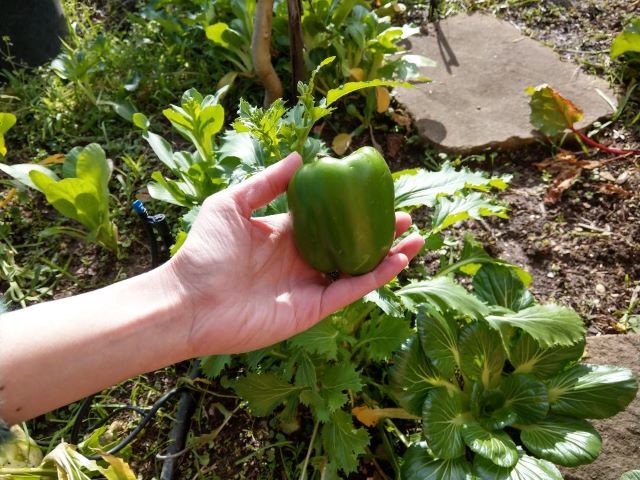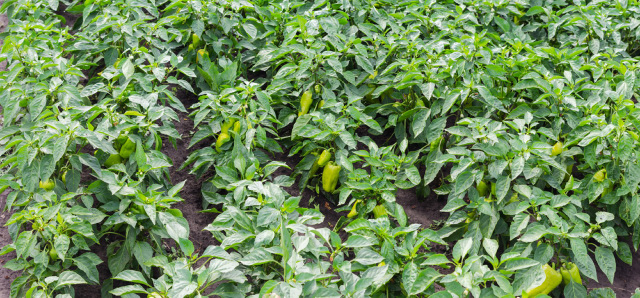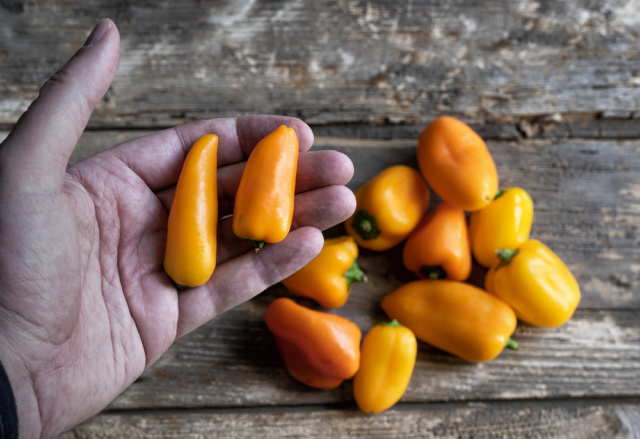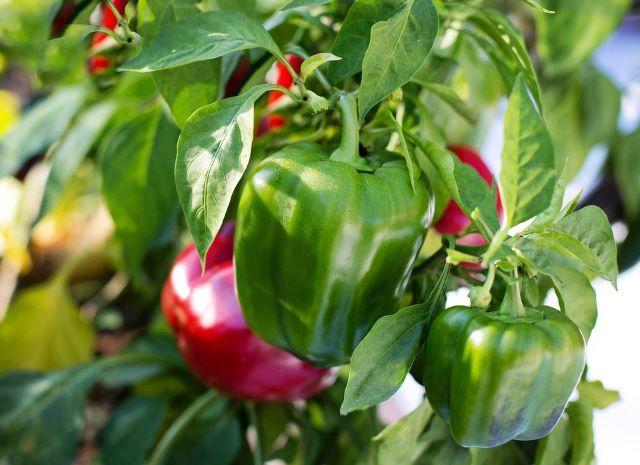Bell peppers are a delicious, vibrant, and versatile addition to the kitchen. If you’re growing them yourself, you’ll likely want them to grow as big as possible! If you’re worried that your bell peppers are looking a bit small or stunted, there are fortunately a number of things you can do to try to remedy this.

If your bell peppers are small it’s usually due to watering problems, poor soil conditions, overcrowding, or inconsistent temperatures.
Let’s take a closer look at each of these causes and how you can try to resolve them. We’ll also share some additional tips that can help you provide the best possible environment for your bell peppers to thrive!
By the end of this article, you’ll be far more confident in creating the perfect conditions for bell peppers to grow as big as you want them. More for you, more for the kitchen, more for your hungry guests! Let’s get gardening.
Related: Bell Pepper Pests
Table of Contents
Watering Problems Cause Small Bell Peppers
Bell peppers are relatively thirsty plants. They prefer consistently moist soil in order to thrive. It’s a good idea to keep the soil slightly damp for the duration of the growing season.
A drip hose or steady irrigation system can help with this. Bell peppers aren’t going to respond well to periods of drought, interspersed with bouts of intense watering. This inconsistency can lead to stunted growth and poor bell pepper fruit yields.
You want to keep moisture levels consistent, with the soil moist to at least an inch below the surface. Mulching when your bell pepper plants are young can help retain moisture in the soil, while also helping to suppress weeds. Surface moisture retention is particularly important given that bell peppers prefer to be planted in full sun.
We’ll talk in more detail about soil quality later, but in terms of drainage, you want your bell peppers to be kept in soil that is well-draining. Whilst they prefer a consistently moist top layer, bell peppers do not want to be kept in stagnant water or soil that is wet for long periods of time. This can cause roots to rot, leading in turn to reduced nutritional intake and smaller bell peppers.
When watering your bell pepper plants, ensure you are watering around the base of the plant and avoid covering the leaves. Wet leaves can lead to scorching damage if in sunny, hot weather. Consistently damp bell pepper leaves also encourage various forms of plant disease and fungal growth.
Poor Soil Conditions Cause Small Bell Peppers
Just as bell peppers need to be kept well watered, they also need to be kept well fed. Peppers require soil that is rich in organic matter in order to produce big, healthy fruit. A lack of nutrients in the soil can result in stunted growth and small bell peppers.
Make sure your young bell pepper plants or seedlings are planted into soil that has organic matter such as aged compost or manure. It is also a good idea, once seedlings have found their feet and rooted comfortably in their bed, to add organic, nitrogen-focused fertilizer to help them on their way.
Adding nitrogen to the soil in the early stages of the bell pepper plants’ development can help with strong, leafy green growth. Later in the season, when the bell pepper plant is ready to start producing fruit, it’s a good idea to switch to a more balanced fertilizer like this one or one with higher levels of phosphorus or potash like this one.
Too much nitrogen at the fruit-producing stage can cause the plant to prioritize further green growth over fruit production. This can potentially result in smaller bell peppers.
Overcrowding Can Cause Bell Peppers To Be Small

People often underestimate the amount of space a bell pepper plant needs for it to reach its full potential. If bell pepper plants are crowded too close together, they will compete for nutrients. This can result in smaller bell pepper fruits across the board.
As a good starting point, it’s a good idea to leave at least 24 inches (61 cm) between each bell pepper plant. This will give it enough space to do its thing and grow the peppers you want to see!
Similarly, if you are planning to keep your bell peppers in pots, make sure you are using vessels that are big enough for the plant. I’ve seen advice out there saying that a pot of 12-inch (30 cm) diameter is the minimum. I would say that you might even want to go a touch bigger than this! Any smaller and you risk the plant becoming pot-bound once it reaches a certain size, which could limit the peppers’ potential.
Bell peppers plants will perform far better if they don’t have weeds to contend with. Ensure you’re weeding your garden bed regularly. Consider using mulch as a way of suppressing unwanted weeds and, at the same time, helping the soil retain well-needed moisture.
Inconsistent Temperatures Cause Small Bell Peppers
Bell peppers are originally sub-tropical plants. Although you’ll now see them being grown in gardens up and down the land, they do in fact require a certain temperature band in order to thrive.
Bell peppers really need consistent daily temperatures of between 70°F and 84°F (21°C and 29°C). If they go much higher or lower than this, they’re going to struggle. Sudden spikes or drops in temperature can damage bell pepper blossoms and lead to stunted or small fruit.
Depending on your local climate, timing the planting of your bell pepper plants can be important. Overall, they have a relatively long growing season – up to 120 days for some varieties. You want to try to give them as much of their preferred temperature as possible during this period.
If growing bell peppers from seed, it’s a good idea to start them off indoors so that you have more control over the temperature. You can also grow them straight from seed in the garden, but you’ll want to wait until the weather starts to turn warm. In temperate climates, this can sometimes place a limit on the full amount of time bell peppers have to grow and fruit.
To give your bell peppers a good head-start, try growing them indoors from 6-8 weeks before your last frost. If you put them in the ground too soon, before the soil has warmed sufficiently, you risk having smaller peppers further down the line.
At this stage, it can also be easy to underestimate the amount of sunlight they require. Young pepper plants especially can really do with plenty of light. If growing indoors, consider investing in an affordable grow light and trying to make sure they get 14-16 hours a day.
Once they’re out in the garden, protect young bell pepper plants or seedlings from any late frosts. If you think the temperature is likely to drop significantly, consider using floating row covers for the first few weeks in order to help the soil maintain enough warmth.
Bell peppers are relatively resilient and can certainly survive colder snaps. The problem is that the stress this places on the plant can lead to stunted fruit growth later. This can cause your bell peppers to end up smaller than you’d like!
Some gardeners who are not blessed with relatively predictable weather may want to consider keeping their bell peppers in pots. This gives you far more control over where they are placed and when. It also means you can move them out of harm’s way if rogue weather comes through.
Small Bell Pepper Varieties

If your bell pepper plant is producing small fruit, consider the variety of bell pepper you’re growing. Some bell pepper varieties are small and could be mistaken for hot or chili peppers. But in reality, they are all part of the same genus Capsicum.
Look out for ‘mini’, ‘petite’ ‘baby’ and ‘cherry’ on your seed label for starters.
Tips For Growing Large Bell Peppers

If selecting bell pepper plants from a nursery, opt for seedlings with three to five sets of healthy-looking leaves. You want to avoid young plants that are too tall, spindly, or gangly. Go for shorter, stronger-looking plants.
Additionally, don’t select bell pepper plants that have already flowered or developed small peppers.
Some gardeners advocate for ‘pinching out’ early blossoms or removing small, young peppers when they first start to appear. This allows the plant to continue growing and to prioritize later, hopefully, larger fruit.
It is often the case that plants producing lots of peppers tend to produce smaller peppers on average. If large individual bell peppers are what you’re going for you might want to limit the number of peppers your plant is growing in the earlier stages.
Remember, bell peppers have a relatively long growing season. It can take anywhere from 90 to 120 days for them to fully mature. Try to be patient. As long as your peppers are looking healthy, try to wait for them to stop growing before plucking them. You might find they have another inch to give!
Related Reading:
